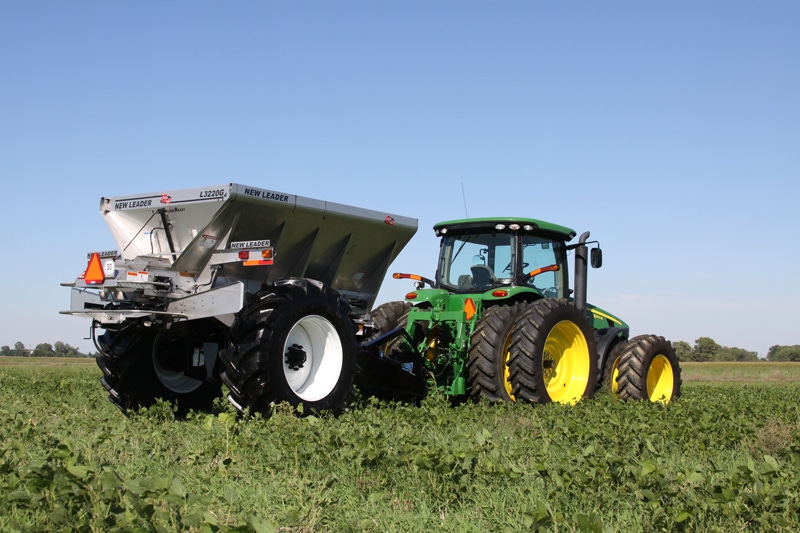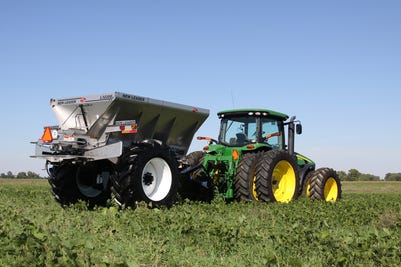July 3, 2014

Spinner spreaders aren’t just for your local fertilizer dealer anymore. Those high-capacity box rigs that you’d hire someone to pull are now being purchased by farmers who have enough acres to justify the price tag. Farmers buying say it gives them more control over when their dry, granular fertilizer is applied.
“Definitely the market is shifting to growers because they are getting bigger,” says Ingrid Livingston, marketing director for New Leader, the nation’s largest spreader manufacturer. “If they have enough acres, 3,000 to 5,000, they know that long-term if they buy this and apply dry fertilizer themselves, it will pay for itself.”

New Leader unveiled their newest unit in August at the Midwest Ag Industries Exposition. The NL200G4 spreader box was paired with the new John Deere R4030 to create a multi-season liquid/dry chassis in as little as four hours.
John Fulton, extension specialist with Auburn University, estimates sales of these dry boxes in his home state of Alabama have increased anywhere from 20 to 50 percent among farmers in the last two years.
Farmers are typically buying the trailer-drawn units that can be pulled behind a tractor or mounting units on truck frames they already own. Self-propelled sprayers equipped with dry-box capabilities provide another option. Some farmers have worked their way up to commercial truck-propelled rigs called “floaters” on the used market.
The uptick in sales coincides with changes in nutrient management practices. In the last two years, there has been a push in topdressing corn. Spinners mounted on a high-clearance frame give farmers another way, in addition to side-dress units, to do that.
“I think this [topdressing trend] started because farmers are looking for ways to supply N after wet springs when some of the pre-plant N gets lost,” says Dr. Fabian Fernandez, crop sciences professor with the University of Minnesota.
Another driver is the increased use of micronutrients, including zinc, boron, and manganese associated with grid soil sampling. The prescription created from the sampling often calls for rate changes of each nutrient independently of the other nutrients. Spreaders can be equipped with dividers that allow for multi-product application in a single trip.
“This capability really developed a couple decades ago with the evolution of air machines in the application market,” says Pauley Bradley, John Deere nutrient application product manager. “It’s only been in the last ten years that the same capabilities to compartmentalize dry fertilizer sources that independently vary their rate on the go were built into dry spinner spreaders.”
Farmers who are looking to buy a new spinner spreader will find the units have changed a lot in the last 10 years. In the old days, they got a bad rap for having an uneven application and limited spread width that would take days to cover fields. New designs and technologies, coupled with improved fertilizer formulations, have addressed those issues (see sidebar on what to look for).
“Ten years ago, the maximum spread width was 50 to 60 ft., so it would take time to put out granular fertilizer,” says Auburn University’s Fulton. “But today, you can get a spreader applying fertilizer 90 to 100 feet, and cover a lot of acres per hour.”
Adds John Deere’s Bradley: “Some fertilizer manufactures have optimized their formulation to make their prills harder and a little larger so the spinners throw them further. This translates to wider spread widths (90 or 100 ft. rather than 70 or 80 ft.) which means fewer passes in the field and more acres per hour/day.”
Next, you'll find some of the technologies and features to consider when shopping for a spinner spreader
What to look for when buying
Modern rate controller. “Invest in a good one,” Fulton says. Then check your operator’s manual to  determine the calibration speed you need to enter in your display. Conduct a stationary catch test to ensure the rate you entered is the rate that is actually being applied. If it doesn’t match, adjust the calibration factor in the display until the application is less than 5% of what your target is.
determine the calibration speed you need to enter in your display. Conduct a stationary catch test to ensure the rate you entered is the rate that is actually being applied. If it doesn’t match, adjust the calibration factor in the display until the application is less than 5% of what your target is.
Variable rate technology. Vehicles equipped with hydraulics can be outfitted with hydraulically- driven controllers that automatically adjust the rate of fertilizer applied according to the changing needs of the soil or crop. Those needs can be measured with grid/zone soil sampling or crop sensors. The package includes GPS, a display screen, mapping software, and hydraulic drives that control conveyer speed, which adjusts the rate applied.
High-clearance chassis. Important if you plan to topdress corn. Dry boxes can be mounted on a self-propelled sprayer or truck to provide the necessary crop clearance. High-clearance trailer chassis also are available.
Tire package. New large-flotation tires can carry the weight of high-capacity spreaders with minimal ground compaction compared to standard tires. Another option, for in-season application, is tall, narrow row-crop tires, about the same size used on rear of a 2WD tractor, can run in between the rows during the growing season without damaging the crop.
Multiple bins. If you plan to apply more than one product, including seed or micronutrients, look for spreaders that are designed with multiple bins, or bin inserts. Some have as many as four bins. Multiple bins allow you to apply up to four different products independently at different rates.
Isobus. Make sure the spreader’s electronic control system and the tractor are ISOBUS-compliant. This ensures that you can plug the spreader harness right into the tractor’s ISOBUS connector, which allows the display to recognize what implement is being towed.
Quality of pellets. Invest in a high-quality crop nutrients. Pellets should be hard and equal in size and shape, without dust or debris. This will give you the maximum spread width and an even spread pattern. New Leader sells a kit that tests for size, grade, and hardness.
Lime capabilities. Some fertilizer spreaders also have the ability to apply lime. The spread width for lime is narrower than fertilizer so make sure to follow manufacturers’ recommendations on setup and calibration.
Crop Canopy Reflectance Sensors. Capable of interpreting the N need of the crop in real time to allow for on-the-go rate changes. “Some research has found the sensors do a better job of predicting the N need of corn plants around the V8 or later stage of growth, a stage that is approaching the limit for most anhydrous ammonia and urea ammonium nitrate toolbars pulled behind tractors ,” says John Deere’s Bradley. “Thus, the spinner spreader is sometimes considered a good option to spread treated urea in conjunction with the sensors because the high clearance sprayer (with spreader) can spread in the V8 or later growth stage of corn where the sensors do a good job.”
Buyer’s Guide
Here are just a few of the companies who make spinner spreaders:
About the Author(s)
You May Also Like




